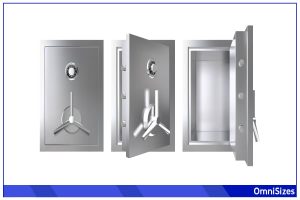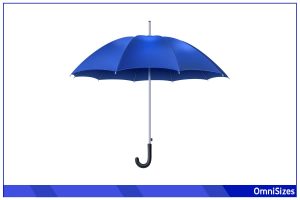Unless you’re a huge footwear geek, you probably won’t give a second thought about shoe box sizes. However, there’s a lot we can unpack about these seemingly unimportant storage compartments beyond whether or not our shoes fit in them.
The most common shoe box sizes for different types of footwear are typically 14 × 10 × 5 inches for men’s shoes, 13 × 7.5 × 4 inches for women’s shoes, and 9 × 6 × 3 inches for children’s shoes, with slight variations based on the type and style of the shoe.

This guide will explain the principles of shoe box sizing, the sizes for various types of footwear, and much more.
Basic Principles of Shoe Box Sizing
Shoe box-sizing is more than just finding a space to stash your new kicks. It’s a blend of design, practicality, and marketing.
Why Size Matters
When you invest in a pair of shoes, you’re not just paying for the design and comfort; you’re also paying for the experience. That experience starts with unboxing. The right shoe box size ensures that your shoes are snug, but not too tight. It prevents unnecessary movement inside, reducing the risk of dents, scratches, or deformation.
Larger footwear styles like boots or high heels require more space to retain their shape, while sneakers or flats might fit into a more compact box. A misfit box can lead to crushed shoes, faded colors, or bent heels. Hence, the box size is tailored to the shoe type to ensure maximum protection.
Standardization of Shoe Box Sizes
Standardization plays a big role in shoe box-sizing. Brands often follow certain industry standards when deciding on box dimensions. This standardization makes it easier for retailers to display products and for consumers to store them at home.
For those who love statistics, here’s a fun fact: Studies have shown that standardizing shoe box sizes can lead to significant savings for brands in terms of material costs and storage. It also helps reduce the carbon footprint associated with shoe production and distribution.
Different Categories of Footwear and Their Box Sizes
When it comes to footwear, there’s no one-size-fits-all approach. From casual sneakers to elegant stilettos, the type of shoe can vastly change the dimensions of its box.
Men’s Footwear Boxes
- Formal Shoes: A staple in many wardrobes, men’s formal shoes, like oxfords or loafers, require boxes that accommodate their shape without squishing them. A common box size for these shoes might be around 13 × 7 × 4.5 inches. The elongated design of most formal shoes, coupled with materials like leather, demands a box that offers both protection and space.
- Athletic Shoes: Men’s athletic shoes or sneakers often have thicker soles and a more robust design. Their boxes tend to be slightly larger, around 14 × 10 × 5 inches. This extra space helps protect the shoe’s design elements, like logos, laces, and unique patterns.
- Boots: Boots, whether they’re ankle-length or go up the calf, need more vertical space. As a result, boxes for men’s boots can be taller, with dimensions like 14 × 8 × 6 inches, ensuring the boot’s integrity is preserved.
Women’s Footwear Boxes
- Heels and Pumps: High heels and pumps have a unique silhouette, with a raised heel that needs its own space. These boxes are usually sized around 13 × 7.5 × 4 inches, providing room for the heel without it touching the box’s top or sides.
- Flats and Sandals: Flats and sandals are more streamlined, often requiring less space. Their typical box sizes hover around 11 × 6 × 3.5 inches. While these shoes may not have the bulk of heels or boots, their delicate designs still necessitate careful storage.
- Boots: Women’s boots, be they knee-high or ankle boots, require boxes that accommodate their height and design elements like zippers or buckles. You might find these in boxes sized around 12 × 7 × 5.5 inches.
Children’s Footwear Boxes
- Infant Sizes: Tiny feet need tiny boxes! Infant shoes are petite, often adorned with cute designs or soft materials. Their boxes are usually around 5 × 3.5 × 2.5 inches, perfect for those little booties.
- Toddler Sizes: As kids grow, so do their shoes and, consequently, their shoe boxes. Toddler shoe boxes might measure approximately 7 × 5 × 3 inches. These boxes are often colorful or have fun designs, making them attractive to young ones.
- Kids and Youth Sizes: For older kids and pre-teens, shoe sizes become more varied. Depending on the design—be it school shoes, sports sneakers, or casual footwear—the box sizes might range from 9 × 6 × 3 inches to 10 × 6.5 × 4 inches.
Storing and Organizing with Shoe Boxes
Shoe boxes are versatile storage solutions, from stacking them in closets to repurposing them for crafts.
Effective Shoe Storage Techniques
- Stack Them Right: One of the most common uses of shoe boxes is stacking them in closets or under beds. When doing so, it’s best to place heavier boxes, like those for boots, at the bottom. Lighter boxes, such as those for sandals, can be stacked on top.
- Labeling is Key: If you’re a shoe enthusiast with multiple pairs, labeling boxes can save time. Using stickers, tags, or even a simple marker, jot down details like shoe type, color, and size. Some even take photos of the shoes and attach them to the box for a visual cue.
- Rotation Strategy: Wear and tear can be minimized by rotating shoes regularly. By organizing boxes such that you’re reminded to wear different pairs, you can extend the lifespan of your footwear.
Repurposing Shoe Boxes
- Document Organizer: Turn shoe boxes into handy organizers for bills, letters, and important documents. By labeling them by month or type, you can keep track of paperwork with ease.
- Gift Boxes: With a little creativity, a shoe box can be transformed into a beautiful gift box. Wrap it in decorative paper, add some ribbons, and it’s ready for gifting.
- Photo Boxes: Convert shoe boxes into stylish photo storage. Wrap them in fabric or decorative paper and use them to store and categorize your cherished memories.
- Drawer Dividers: Cut shoe boxes into desired sizes and use them as dividers inside drawers. They can help segregate underwear, socks, and accessories, keeping drawers neat.
- DIY Wall Shelves: With some reinforcement, shoe boxes can become chic wall shelves. Paint them in colors matching your decor, fix them to walls, and you have instant storage cum decor.






